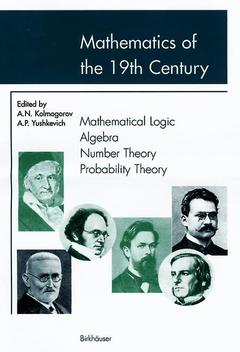Description
Mathematics of the 19th Century (2nd Ed., 2nd rev. ed.)
Mathematical Logic Algebra Number Theory Probability Theory
Coordinators: Kolmogorov A.N., Yushkevich A.P.
Language: English
Keywords
Mathematics of the 19th century, Vol. 1 Mathematical logic algebra number theory probability theory
Publication date: 03-2001
308 p. · 15.5x23.5 cm · Paperback
Publication date: 03-2001
308 p. · 15.5x23.5 cm · Paperback
Mathematics of the 19th century, vol. 1 Mathematical logic algebra number theory probality theory
Publication date: 03-2001
308 p. · 15.5x23.5 cm · Hardback
Publication date: 03-2001
308 p. · 15.5x23.5 cm · Hardback
Description
/li>Contents
/li>
This multi-authored effort, Mathematics of the nineteenth century (to be fol lowed by Mathematics of the twentieth century), is a sequel to the History of mathematics from antiquity to the early nineteenth century, published in three volumes from 1970 to 1972. 1 For reasons explained below, our discussion of twentieth-century mathematics ends with the 1930s. Our general objectives are identical with those stated in the preface to the three-volume edition, i. e. , we consider the development of mathematics not simply as the process of perfecting concepts and techniques for studying real-world spatial forms and quantitative relationships but as a social process as well. Mathematical structures, once established, are capable of a certain degree of autonomous development. In the final analysis, however, such immanent mathematical evolution is conditioned by practical activity and is either self-directed or, as is most often the case, is determined by the needs of society. Proceeding fromthis premise, we intend, first, to unravel the forces that shape mathe matical progress. We examine the interaction of mathematics with the social structure, technology, the natural sciences, and philosophy. Through an anal ysis of mathematical history proper, we hope to delineate the relationships among the various mathematical disciplines and to evaluate mathematical achievements in the light of the current state and future prospects of the science. The difficulties confronting us considerably exceeded those encountered in preparing the three-volume edition.
One Mathematical Logic.- The Prehistory of Mathematical Logic.- Leibniz’s Symbolic Logic.- The Quantification of a Predicate.- The “Formal Logic” of A. De Morgan.- Boole’s Algebra of Logic.- Jevons’ Algebra of Logic.- Venn’s Symbolic Logic.- Schröder’s and Poretski-’s Logical Algebra.- Conclusion.- Two Algebra and Algebraic Number Theory.- 1 Survey of the Evolution of Algebra and of the Theory of Algebraic Numbers During the Period of 1800-1870.- 2 The Evolution of Algebra.- 3 The Theory of Algebraic Numbers and the Beginnings of Commutative Algebra.- Three Problems of Number Theory.- 1 The Arithmetic Theory of Quadratic Forms.- 2 Geometry of Numbers.- 3 Analytic Methods in Number Theory.- 4 Transcendental Numbers.- Four The Theory of Probability.- Laplace’s Theory of Probability.- Laplace’s Theory of Errors.- Gauss’ Contribution to the Theory of Probability.- The contributions of Poisson and Cauchy.- Social and Anthropometric Statistics.- The Russian School of the Theory of Probability. P.L. Chebyshev.- New Fields of Application of the Theory of Probability. The Rise of Mathematical Statistics.- Works of the Second Half of the 19th Century in Western Europe.- Conclusion.- Addendum.- 1. French and German Quotations.- 2. Notes.- 3. Additional Bibliography.- Bibliography (by F.A. Medvedev).- Abbreviations.- Index of Names.
© 2024 LAVOISIER S.A.S.




